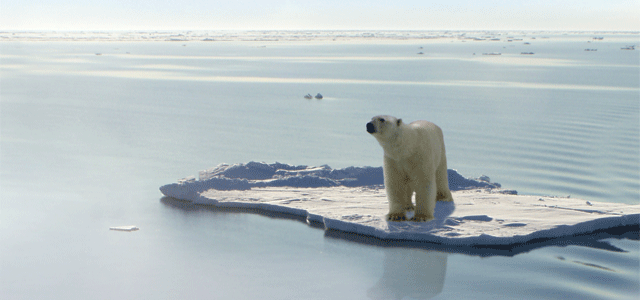
The Arctic sea ice has hit a new low. It is smaller, patchier and thinner than ever—even described as “rotten” in parts.
According to Louis Fortier of the University of Laval in Québec, Canada, we have good cause for concern for our Arctic environment, which is under stress. “In plain words, we are three-quarters of the way to a summertime ice-free Arctic Ocean, with all the climactic, geopolitical, environmental and economic consequences,” says Fortier.
The Arctic Ocean is covered by a thick, floating icecap, the breadth of which fluctuates with the seasons and currents. Each summer, the icecap shrinks to an annual minimum in mid-September before growing out again, fuelled by plummeting winter temperatures and long nights.
However, Arctic air temperatures today are rising twice as fast as the global average, and scientists predict that the region could see temperatures rise between 6°C and 14°C by 2100, depending on how fast the sea ice disappears.
Constant, real-time monitoring by the US National Snow and Ice Data Center (NSIDC) reported in August 2012 that the ice pack had shrunk to 4.1 million square kilometres. That is 70,000 square kilometres smaller than the 2007 low, when the summer thaw opened up the
North West passage for the first time in living memory.
Scientists studying and monitoring the ice thickness are concerned for a number of reasons. One is the fact that less ice in the Arctic means light enters the ocean beneath, fuelling more life.
Timing is of particular concern. The sun reaching Arctic waters earlier means the annual cycle of life kicks off earlier, creating problems for large species like whales, whose migrations coincide with the historical onset of spring.
In the Beaufort Sea to the north of Alaska, the biomass of ice algae, which cling to the underside of ice floes and occupy the lowest link of the food chain, was more than three times that reported in 35 years of seasonal observations.
The algae feed tiny zoo plankton, which provide vital energy supplies for organisms higher up the food chain. Less ice, says George Hunt of the University of Washington in Seattle, could cause a cascade of changes to these food chains.
More light into the ocean also means warmer surface waters and more energy released into the atmosphere. This energy drives cyclones, which do great damage to the ice pack, degrading it even further.
Another concern is the ice thickness—or lack of it. From 1979 to 2000, the average volume of Arctic ice in September was 12,000 cubic kilometres. By 2012, it was less than 3000 cubic kilometres.
Several factors are to blame. For a start, warmer spring temperatures than usual. On August 5 last year, a major cyclone crossed into the Arctic Circle. Events like this used to be rare but are increasing in frequency and intensity. These cyclonic winds carry the warmth from the lower latitudes and stir up the Arctic waters, bringing warm water to the surface where it further melts the ice. As the ice melts, it leaves the whole area unprotected from wave action, further shredding any ice floes they encounter.
The result of this upheaval is not just confined to the Arctic Circle. The contrast in weather between the hot tropics and cold poles is needed for our weather patterns all over earth. It drives the jet streams, for example, that fuel the wind that powers ocean currents and redistributes moisture around the earth.
Further, the melting Arctic ice is diluting the North Atlantic Ocean and Baffin Bay (off the coast of Greenland) with freshwater, which may slow the circulation of the Atlantic, which in turn pushes water through the oceans of the world. The result is that the latest climate models predict an ice-free Arctic summer by around 2050.
It is not a positive picture.
When I read reports like this from around the world, it reminds me of what the Psalmist said years ago, as he thought about the immutability of God and the transience of man and creation: “In the beginning you laid the foundations of the earth, and the heavens are the work of your hands. They will perish, but you remain; they will all wear out like a garment” (Psalm 102:25, 26).
Many today believe we are living at the turning point of human history. Not only are natural disasters intensifying but so also are those which are caused by irresponsible management of the resources God has given to humankind.
Even a casual observer is aware of the over-population crisis, the environmental crisis, the world food crisis and raw material crisis, to name just a few.
The current threat to human survival has arisen because humankind’s increasing power over the environment has not been matched by increasing wisdom and restraint. Human beings have been unfaithful stewards of God’s creation, or careless at the very least. Their concern to satisfy present needs has taken precedence over possible future consequences.
Thinking about these crises can be depressing. However, as a Christian, I believe there are great reasons to be optimistic.
In the words of the apostle Paul: “For the creation was subjected to frustration, not by its own choice, but by the will of the one who subjected it” (Romans 8:20). Adam’s and Eve’s choice of disobedience caused paradise to be lost and the whole world suffered the consequences of their rebellion and sin. But one day soon, even nature is going to be perfect again when paradise is restored.
I am looking forward to that day of restoration—of all things—when Christ returns, how about you?









